Liveblog: salmon-orca workshop II
Live blog from the second workshop on “Evaluating the Effects of Salmon Fisheries on Southern Resident Killer Whales” began today (3/13/2012) in Vancouver, B.C. During this second step in a process NOAA initiated to manage chinook salmon with attention to southern resident recovery, a U.S.-Canada science panel will revisit some of the questions posed during and after the first workshop, including: population status; feeding habits; fisheries that may affect prey availability; relationship between Chinook abundance and population dynamics; Chinook needs, abundance, reductions, and food energy available. Specific goals are to discuss changes to the population modeling (FRAM, Baysian posterior estimate) and review new data on winter food sources and availability.
Most presentations include links to the slides (PDF or PPT) archived on the workshop web site. Select presentations also include a link to the audio recording of the presentation.
Day 1 (3/13/2012)
8:45 Ray Hilborn reviews science panel impressions from first workshop
His presentation summarized the types of information requests that will be addressed over the 2.5 day workshop —
– Explore the different hypotheses of why the SRKW population is so small
– How does the density of SRKW compare to the densities of KW in other areas?
– What are the legacy effects of removals for the aquaria trade?
– What else is eating Chinook and how much are they eating?
9:00 Teresa Ryan: Indigenous Knowledge Systems: An Overview
Ways that indigenous knowledge systems could increase awareness of the contribution these knowledge systems can make to natural resources management.
- There are 5 different names for eulachon (including a general term and names for successive runs, indicating to fish biologists that there are 4 runs of returning adult eulachon).
- In Tlingit, there are 3 names for 3 artistic depictions of killer whales (‘sit, or ‘kit) which may represent a “point of convergence” of indigenous knowledge and scientific recognition of three regional ecotypes: offshore, transient, and resident.
9:30 break
9:40 Eric Ward: Comparison of SRKW and NRKW population dynamics slides | audio (mp3)
Is the population declining?
While SRKW population has declined in some years historically, estimates of λ are overwhelmingly positive (mean λ of 1.023)
Remember:
• Lambda (λ) quantifies the long term time- invariant, deterministic growth rate of a population at equilibrium
– “long term†= on scale of decades
– Replacement of females by females
– *Different than regression of population size!• Lambda doesn’t incorporate temporal fluctuations
– Environmental and demographic stochasticity – Population age and sex structure
NOTE: juvenile survival is most important [with implications for the death of L-112 who fell in the age 2-10 year-old age class in the model]
How have actual growth rates changed?
Why isn’t the population increasing more quickly?
Possibly because there is a male bias in the southern residents…
All pods have positive growth rates, and K / L pod’s expected growth rates appear to have increased recently
Sex ratio at birth
— 45% of births since are female (44/96 v 76/140)
— NOT a statistically significant differenceMales, males, males
Reproductive and younger animals (< 20)
Stochastic birth and deaths
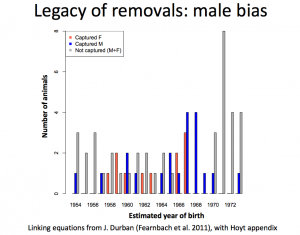
The male bias in the wild southern resident population may be due in part to a sex bias in the historical captures.
Why are there more males?
1. Compensation for historic removals? (male biased harvest)
2. Compensation for lower survival rate (males v females)?
3. Interaction with contaminants?
4. Trends in age of male or female SRKW?
- Moose: as mean male age drops -> fewer males
- BUT mean male age in SRKW has gotten younger
5. Older males more likely to father male offspring?
– White tailed deer, old SRKW males father lots of offspring
6. Density dependent response to slow down population growth?
– Generally opposite of what’s been observed for other long-term studies of mammals (red deer, sheep, other ungulates)
10:00 break
10:20 Ward continued | audio
How do southern and northern resident models (posterior distributions) differ?
SRKWs have lower fecundity — For females of a given age (23), NRKW fecundity is on average 35% higher
Mortality rates are different (not comparable as reported in 1st workshop)
NRKW are about 130% higher (not 200% as reported in 1st workshop)
Apply mixed effects models to examine variability among clans / pods / matrilines
Updated comparison of density dependence / covariates, with NRKW and SRKW
“Age is the major driver of fecundity, with co-variates like salmon being secondary.”
Models with density dependence (esp females) do better than salmon only models
 What drives fecundity and survival? — Prey? Density dependence? Both?
SRKW and NRKW populations are correlated (e.g. drops in the 1990s are likely due to environment (and not age structure of SRKW)
Summary slide
1. SRKW have smaller λ than NRKW
–  Lower fecundity
–  Lower survival
–  K/L pod have skewed sex ratio (< 40% female in recent yrs
–  Fewer female births
2. Estimating random effect deviations for SRKW is difficult
– Regional (N/S) difference is better predictor
3. Fecundity: SRKW and NRKW have a similar response (+ with + salmon) – Suggests salmon difference isn’t responsible for smaller growth of SRKW4. Survival: density dependence (total females) receives most support
–  DD effect is weak in SRKW, less than the effect of increasing CTC index
–  DD effect is stronger in NRKW & smaller than salmon effect
–  DD effect too small to explain the lower λ (or survival) for SRKW
5. Support for “Moran’s effect†(correlated dynamics between NRKW and SRKW), synchrony a result of environment because dispersal=0
– Populations correlated, drops in the 1990s likely due to environment (and not age structure of SRKW)
11:10 Mike Ford — Estimating the historical size of the southern resident killer whale population | audio
Motivating questions from the science panel:
- Perhaps the SRKW population has always been small?
- How does the density of SRKW compare to the densities of KW in other areas – NRKW, Alaska, other?
Note that the number of whales per 1000 km^2 varies and is often driven by productivity of habitats. SRKWs are about 0.9 whales/km^2, vs 1.7 for NRKWs, 0.9 for SE AK residents; SAR residents 10.7; Kenai/Aleutians 6-29; Norway 6.1-6.5.
Genetic modeling approaches
Coalescent simulation vs MCMC likelihood approximation
Hoelzel et al. (2007) used a 2-population model and found that most modern populations were much less (~10x) than ancestral populations, but divergence timing was typically ~10k years (so not very realistic for SRKW recovery goals)
New approach with a single population model, but data “are not working for me.”
New information and analysis:
- Complete mtDNA genomes are becoming available from all matrilines (collaboration with Phil Morin, John Ford and others).– Much better bounds on the ‘age’ of the SRKW population– Potential for better historical size analysis
- New nuclear sequence• ~50,000,000 base pairs of sequence from 2 individuals (K13, J26)• 10,000+ variable sites
- Microsatellite models recently added to BEAST package (Wu and Drummond 2011)
Audience comment: Remember that for SRKWs, from 80-22k years ago, the habitat was greatly reduced due to glacial ice cover.
11:45 lunch break
13:20 Larrie LaVoy — Comparison of FRAM, CTC and Kope/Parken indices, and other FRAM topics (slides not yet on-line) | audio
In 1st workshop Lavoy estimated percent reduction in Chinook food energy available to SRKW from different fisheries.
Fisheries Regulation Assessment Model (FRAM) is a tool to measure Chinook prey abundance, food energy available and the reduction in prey resulting from salmon fisheries. It is used by both NOAA and WDFW. The counterpart to FRAM for management and assessment of marine area fisheries in Canada and Alaska is the Chinook Model developed by the Chinook Technical Committee (CTC) under Pacific Salmon Commission (PSC). These two models share many common data sets for Chinook stock abundances and exploitation rate information from recoveries of coded-wire-tags.
Chinook Abundance Index (AI) is calibrated annually and is the catch-in-year divided by average annual catch in 1979-1982 (a period when many stocks were tagged and an active set of fisheries). In 2005-2008, the aggregate (across all stocks) AI ranged from 0.39 (in 2006) to 1.00 (in 2007). Note that stocks contributing to the AIs don’t all have the same importance as prey for killer whales.
Inland waters age 3-5 Chinook abundance (Jul-Sep) are typically ~1 million fish.
14:00 Angelika Hagen-Breaux, WDFW — Effects of West-Coast Fisheries on the Abundance of Mature Age Four and Five Chinook in the Salish Sea | audio
This analysis only examines mature 4 and 5 year old Chinook returning to spawn in inside waters. Stocks included any FRAM stock originating in inland waters (Puget Sound, as well as Fraser Earlies, Fraser Lates, and Lower Georgia Strait stocks).
The percent (%) increase in abundance from marine fisheries closures vary from about 3.5% for closure of Puget Sound or all U.S. coastal fisheries (about 0.5% increase of Fraser Chinook), to ~13% for closing Canadian fisheries, ~20% for closing all relevant fisheries.
14:20 Eric Ward — Sensitivity of SRKW population growth rates to changes in salmon abundance indices (PPT) | audio (mp3)
This is not a comparison of fishing vs no fishing… (that’s tomorrow’s presentation: how much fishing impacts KW growth rate and ability to meet recovery criteria). Rather, this analysis examines fishing impacts divided up into coastal vs inland impacts.
Model stratification:
- 21 stocks, 2 stratification approaches considered:
- Ocean Distribution: north, central, California (south)
- Migration timing: spring, summer, summer/fall, fall
Summary of results (1979-2010):
- California stocks and spring/summer stocks appear to be poor predictors of survival
- North/fall migrating stocks are better predictors of survival
- NRKW results alone give more support to fall stocks
In terms of terminal run size, the fall runs are more than 50% of the total of runs from the spring, summer, and fall. (see figure in slides)
What’s not included in fall group?• California stocks (Sacramento, Klamath)• Summer stocks• Spring stocks– Fattier (e.g. Columbia spring)– Workshop 1 result: spring stocks may be most important (Wasser, Ayres et al.)– Importance of spring stocks is not supported by our results [because the Columbia springers are not subject to regulated commercial fisheries?]
Audience (co-author?) comment: Columbia spring salmon are not in our fishery models because they’re not caught in fisheries. (They are are distributed “offshore” whereas the fishing happens along the coast. They come straight into the Columbia and the SRKWs are foraging along the coast so “they aren’t available as prey.”)
Ward: We’re not modeling predation; we’re looking at correlations.
15:00 break
15:30 Mike Ford — Quick review of response to other issues | audio
Comparison of diets determined from fecal samples and prey remains (scales and tissues).
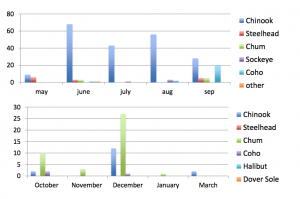
Seasonal patterns in SRKW prey samples. Brad suggested that winter samples were younger Chinook (2-3 year-old).
What is known about K & L pods diet during the winter?
- Not much
- 2 samples from L pod in March (sampled off WA coast; both Columbia River Chinook)
- 18 samples from K pod in December (sampled in Puget Sound; Chinook, chum, lingcod)
Daniel Schindler: The main reason to pursue captive energetic calibration was because the energetic results presented by Noren in workshop 1 were pretty high for a predator — about 7-10%…
Ford: That was addressed that concern in Dawn Noren’s follow-up paper.
Audience: Are any data available from Keiko that would indicate how metabolic demand changed between captivity and an ocean environment?
The question and discussion was fairly extensive (~15:50-16:05) and is captured in the audio recording…
16:10 End of day 1
Day 2:
08:35 John Ford: Resident killer whale feeding habits | audio
Methods of assessing diet in killer whales have different limitations and benefits —
1. Â Chemical tracers (fatty acids, stable isotopes, contaminants) from skin and blubber biopsies
2. Â Prey remains in stomachs of stranded animals
3. Â Direct observation at the surface
4. Â Prey fragments (scales and tissue) recovered from predation sites
5. Â Fecal sampling
How reliable are prey fragments in diet assessment of resident killer whales?
1.  Are surface-Ââ€oriented prey over-Ârepresented?
We believe the majority of prey are brought to surface and broken up, usually for sharing. Adult females shared 90% of prey, males 24%, and subadults 59% (n = 213 feeding events). Salmon seem to be shared most of the time, while other prey may not be shared.
Stomach contents of three stranded residents consistent with sharing of salmonids, but not necessarily other species:
– A09: 19 Chinook, anterior bones only; 15 lingcod (only 2 large), mostly complete
– C16: 6 Chinook, anterior bones only; 5 halibut, 18 Dover sole, apparently complete– Unknown SR female: 1 Chinook, posterior bones only
Sockeye swim at shallower depths than chinook, but rarely show up in surface samples (though sharing is documented with all salmon species taken).
•  Tracking studies in Johnstone Strait indicate that Chinook swim at a mean depth of 69.9 m (± SD 57.3), max 398 m
•  Sockeye tracked in same area swam at mean depth of 14.9 m (± SD 57.3)
•  Sockeye rarely appear in prey samples, despite being > 4 Ames shallower than Chinook
2.  Are large prey sizes overâ€represented?
3.  Are fish with scales that are easily shed over-Ââ€represented?
Conclusions:
Fragment sampling better for accurately determining proporAons of salmonids in diet, rates of prey capture in foraging bouts, and identifying when and where prey are captured
Fecal sampling better for determining presence of non-†salmonids, identifying prey taken over periods of up to several days
Winter-spring predation (by month, November-April)
Chinook are the dominant prey of SRKWs in winter-spring months, though the number of samples per month is small.
Stranded NRKW matriarch A9 had a full stomach ~Dec 7, 1990, containing:
Prey remains:
– 18 Chinook salmon
– 15 Lingcod (only 2 large)
– 5 Greenling
– 8 English sole
– 1 Sablefish
– Various small fishes, likely prey of Lingcod
Most of the ~8 strandings had a few Chinook salmon without other fish bones, but one other had non-salmonid prey — 18 beaks of Boreopacific Armhook Squid.
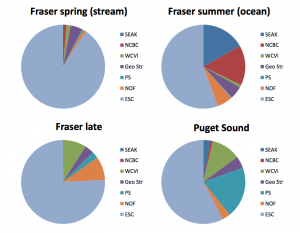
Fishery impacts on Fraser and Puget Sound chinook. Distribution of fishery impacts for major stock groups. Fishery aggregates are: SEAK – Southeast Alaska, NCBC – Northern and Central BC, WCVI – West coast Vancouver Island, Geo Str – Upper and Lower Georgia Strait, PS – Puget Sound and Strait of Juan de Fuca, NOF – coastal fisheries off Washington, Oregon and California. ESC represents escapement from preâ€terminal fisheries
09:30 Robert Kope: Overview of Chinook Fisheries from SE AK to WA | audio
2008 salmon treaty reduced catch ceilings in SE Alaska and on West Coast
Plots combine commercial troll and net, as well as recreational catch.
The Fraser spring (Dome and Nicola indicator stocks) are contacted by very few ocean fisheries, but most contact is in Southeast AK fishery. WA coastal stocks are taken in SE AK (~50%), Northern BC (~20%), and off WA coast (15%?).
The SE Alaska fishery seems to dominate contact with west coast salmon populations.
9:50 John Ford: What Else is Eating Chinook and How Much are they Eating? | audio
• Only concerned with 3–6 yr old Chinook
» Other killer whale populations (new acoustic results suggest possible competition with NRKWs on outer WA/BC coast)
» Harbour seal – Scat studies show lots of salmon in their diet, but dominated by pink (or 3-17% chinook)
» California sea lion – Old scat studies suggest diet is ~35% herring (salmon <~10%)
» Steller sea lion – Salmon important in their diet
10:00 Dave Preikshot: Ecosim modelling in Strait of Georgia | audio included in previous talk by John Ford
Ecosim SRKW biomass estimate matches the recently published age structure time series and could be an interesting metric for gauging recovery. It appears SRKW biomass is missing though total population size has been approximately constant.
Ecosim suggests there has been a decline since 1990s in the mean trophic level of predators in the Strait of Georgia.
Ecosim estimates of sea lion and harbor seal predation on salmon (based on assumption of salmon being 1-5% of their diet) suggests that their combined contribution to chinook mortality may have reached that of SRKWs around 1990.
10:20 Ian Perry: measurements of ecosystem variables, including human factors | audio included in previous talk by John Ford
There have been 3 “regimes” in the last ~40 years
10:35 break
10:45 Questions/discussions regarding last 3 mini talks
10:55 Chuck Parken: Pre-terminal Fisheries Impacts on Fraser River Chinook Stocks | audio
Fraser River stock representation in models (n=2) & by CWT indicator stocks (n=4) was opportunistically-based on the data available
Pre-terminal exploitation for CWT indicator stocks:
— Low for spring & fall stocks (8%-15%)
— High for summer stock (40%)3 of 7 genetic groups did not have CWT indicator stock
Ocean distribution represented less accurately by surrogates
Audience: Which of the 3 indices we’re pondering (CTC, FRAM, Kope/Parken) are best?
Parken: We prefer the Kope/Parken index because it includes coded wire tag data while CTC and FRAM are models.
- 2010 – 1.96M sockeye
- 2011 – 278k sockeye, 3.67M pink
Off WA coast, commercial ocean troll chinook fishery (Areas 2-4)
- More Columbia fish closer to Columbia
- Puget Sound and Fraser fish more abundant further north (closer to entrance to Strait of Juan de Fuca
Highest Fraser proportion is off San Juan Island.
11:24 Craig Bowhay, NWIFC: Ancillary Benefits for SRKWs from the Coast Wide Chinook Management Regime | audio
Please note the statement from the Northwest Indian Fisheries Commission
The transition to abundance-based management and its resulting fishery structure has benefited SRKWs. Human fishing pressure has decreased and escapement has increased, though the total run size has decreased.
SRKW recovery cannot be achieved by reducing harvest. Chinook recovery is required.
Ken Balcomb: The lack of correlation between this time series and the observed changes in SRKW population and social structure suggests that something else is going on.
12:00 lunch break
13:15 Eric Ward – Fishing Impacts on SRKW Growth Rates and Management Criteria | audio (missed first ~5 minutes)
This model uses only terminal index. It manipulates salmon abundance by about 20% and looks effects growth rates (increases ~1.5%).
K and L pod’s growth is slow because of few young females. L-112 was one of only 3 females in the 0-15 year-old range.
The current probability of meeting the PSP’s goal of 95 SRKWs by 2020 is ~60%. If salmon abundance increases by 20% (from its current level of 1200 in the fall terminal index [Parken-Kope]), then the probability increases to ~80%.
If conditions don’t change:
- Probability of downlisting ~ 31%
- Probability of delisting ~ 18%
- Growth rate for SRKWs: λ ~ 1.5% / year
– J growth rate > K growth rate > L growth rate- Probability of growth rate going negative: (λ < 0) ~ 20%
- Most likely scenario: slow growth, no delisting or downlisting or extinction
14:30 David Bernard: Mortality Rates and Birth Rates of SRKWs and CTC Abundance Indices for Fraser-Early and Fraser-Late Chinook Salmon | audio
An aside:
New scientific information and analyses about the Southern Resident population and the extent of their reliance on salmon – particularly large Chinook salmon – strongly suggest that Chinook abundance is very important to survival and recovery of Southern Residents. This relationship has potentially serious implications for salmon fisheries and other activities that affect the abundance of Chinook salmon.
The letter from NOAA Regional Director Will Stelle that initiated the workshop process goes further:
New scientific information and analyses about the Southern Resident population and the extent of their reliance on salmon – particularly large Chinook salmon – have potentially serious implications for any and all activities that affect the abundance of Chinook salmon.
But he goes on to clarify that the initial focus will be on fisheries:
The questions surrounding the effects of fishing on the Southern Residents are immediately before us because the National Marine Fisheries Service (NMFS) currently is evaluating a proposed Resource Management Plan jointly developed and submitted by the Washington Department of Fish and Wildlife and the Puget Sound treaty tribes….
Accordingly, we are proposing to co-sponsor a scientific process designed to identify and summarize the status of the available science pertinent to the effects of fishing on Southern Resident killer whales and means by which key uncertainties and data gaps may be reduced. This scientific process supports the implementation of the Southern Resident killer whale recovery plan, and it will inform salmon fisheries management decisions beginning with the 2013 fishing season.
Some of us will have to remember to ask Director Stelle when similar processes will be put in place to address other activities that affect the abundance of Chinook salmon. In particular, we should be sure he’s not intentionally avoiding the controversial issue of how to manage Columbia River dams for salmon (which is familiar to him!).
For now in these deliberations about fishing impacts, one audience member put it well: All West Coast Chinook stocks should be on the table when considering the needs of the SRKWs.
Day 3:
8:30 Lynne Barre:Â Performance Metrics for Marine Mammals and Other Species | audio
8:58 Three short presentations of John Ford, DFO; Ken Balcomb, Center for Whale Research; Brad Hanson NOAA: Assessment of Potential Food Limitation in Resident Killer Whales: How, When and Where | audio (Ford, Balcomb, and Hanson)
John Ford | audio (Ford, Balcomb, and Hanson)
SRKW catch per unit effort (CPUE) goes up when local salmon indices are low…
A sighting of L pod has been confirmed well north of Haida Gwaii!
Winter – Spring Occurrence of L pod
•  L pod encountered in Chatham Strait, Alaska, 1 June 2007 (Pt. Ellis, 56°34’N, 134°23’W)
•  Sighted off Victoria, inbound, 9 June at 1600 (1300 km minimum in 8 days)
•  Extends known range of SRKW 275 km to the north
•  Overall coastal range now 2500 km
Ken Balcomb | audio (Ford, Balcomb, and Hanson)
The Center for Whale Research has conducted ~2300 surveys since the census efforts began in the 1970s, mostly in the San Juan Archipelago. Outer coast sighting network, including Nancy Black, has accumulated many sightings from central BC to Monterrey Bay. There were about 40 sightings along the coast in 2009 and that amount has approximately doubled now (2012). From 2007-2012 there were 6,094 sightings from public with 372 from outer coast (24 SRKWs).
Noted Ottawa and Algonquin ship tracks in U.S. and Canadian SRKW critical habitat, showed types of aircraft and bombs the U.S. Navy is authorized to use in their take permit, and asked NOAA and DFO to initiate an investigation of stranded cetaceans (2 beaked whales, and 2 killer whales, including L-112) along WA outer coast that he suspects are analogous to the trauma in the Bahamas he observed in beaked whales.
Brad Hanson | audio (Ford, Balcomb, and Hanson)
Passive Acoustic Recorders deployed at 7 sites (as far south as Pt. Reyes) for 4-11 months between 2006-2011. Initially used PALs (limited by 220 samples/day), but switched in 2008 to EARs (30 sec on/ 300s off duty cycle, getting about 11 months off current battery pack). Total effort Jan-June = 2972 days (doubled in 2011), mostly (>75%?) from Cape Flattery in/off-shore and Westport.
129 days of SRKW detections (57 in 2011). SRKWs were detected more often than expected in some years and locations, most notably off the Columbia River.
SRKW calls (except Js) were detected on 11 days during 157 days in 2006.  First detection was not until 37 days after deployment. There were back and forth detections between Westport and Cape Flattery sites.
SRKW calls (except Js) were detected on 57 days during 180 days in 2011.  There were 9 periods that exceeded a week (max 14 days) that there were no detections of SRKWs. Movements suggested by the detection sequence suggests most time spent near Columbia River and Cape Flattery, with at least one excursion for multiple days to vicinity of the Pt. Reyes site in CA.
Albion test fishery in 1981-2006 shows a peak in the spring and then gentle decline during summer. More recently (2007-2011) there are very few fish in April/May and the Albion fishery peaks in the late summer.
Since 2003: SRKWs are arriving later; are present lower proportion of days; during 2009 and 2010 pods were subdivided or only a portion of the pod was present.
Dave Bain: spring behavior of NRKWs seems distinct from later in the season (smaller groups (~7 instead of 30), faster traveling, longer daily distances (200km instead of 100km)). They seem to have two tactics for dealing with nutritional stress: increasing activity and foraging effort vs resting.
John: We need to look more closely at the Southern and Northern RKW mortality rates in the late 1990s. What drove that? What stocks were in decline then?
Process from now on:
4/30/2012 — Science panel produces first draft of report
6/15/2012 — Public comments due on draft report
8/15/2012 — NOAA/DFO comment on Draft 1, including compiled public comments
9/18-20/2012 — Workshop 3
11/30/2012 — Science panel produces its final report
12/31/2013 — NOAA finalizes Alternative Fishing Regimes report
3/31/2013 — NOAA initiates or reiniatiates ESA fishery consultations if necessary
More details in the process diagram.


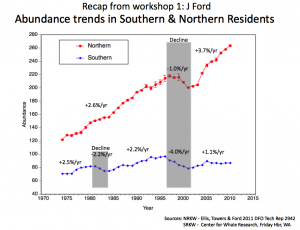
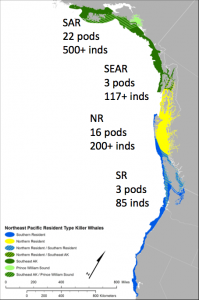
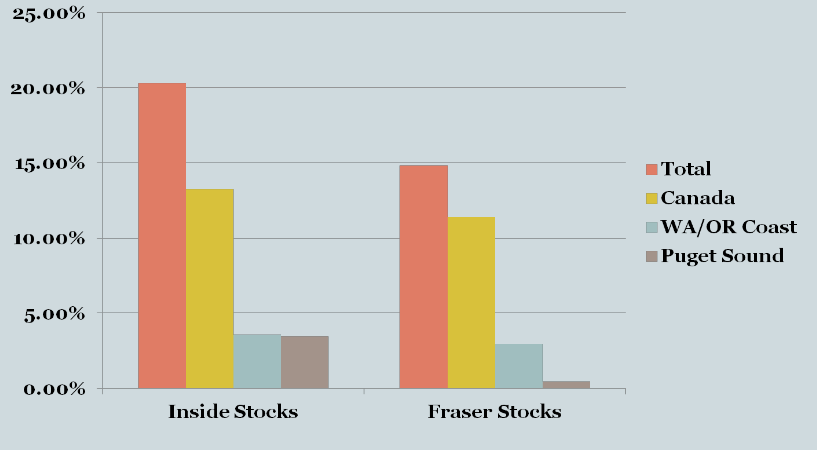
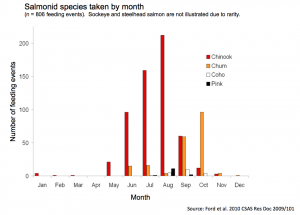
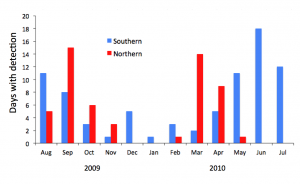
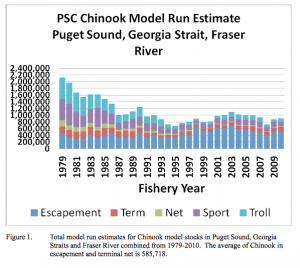

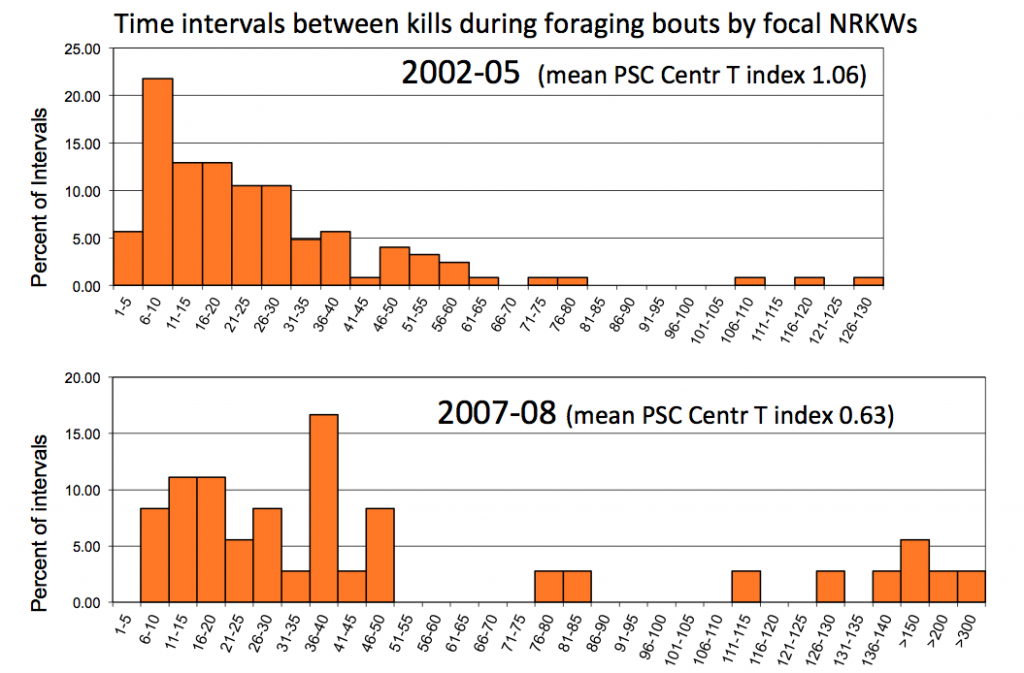


 Twitter
Twitter LinkedIn
LinkedIn Facebook
Facebook